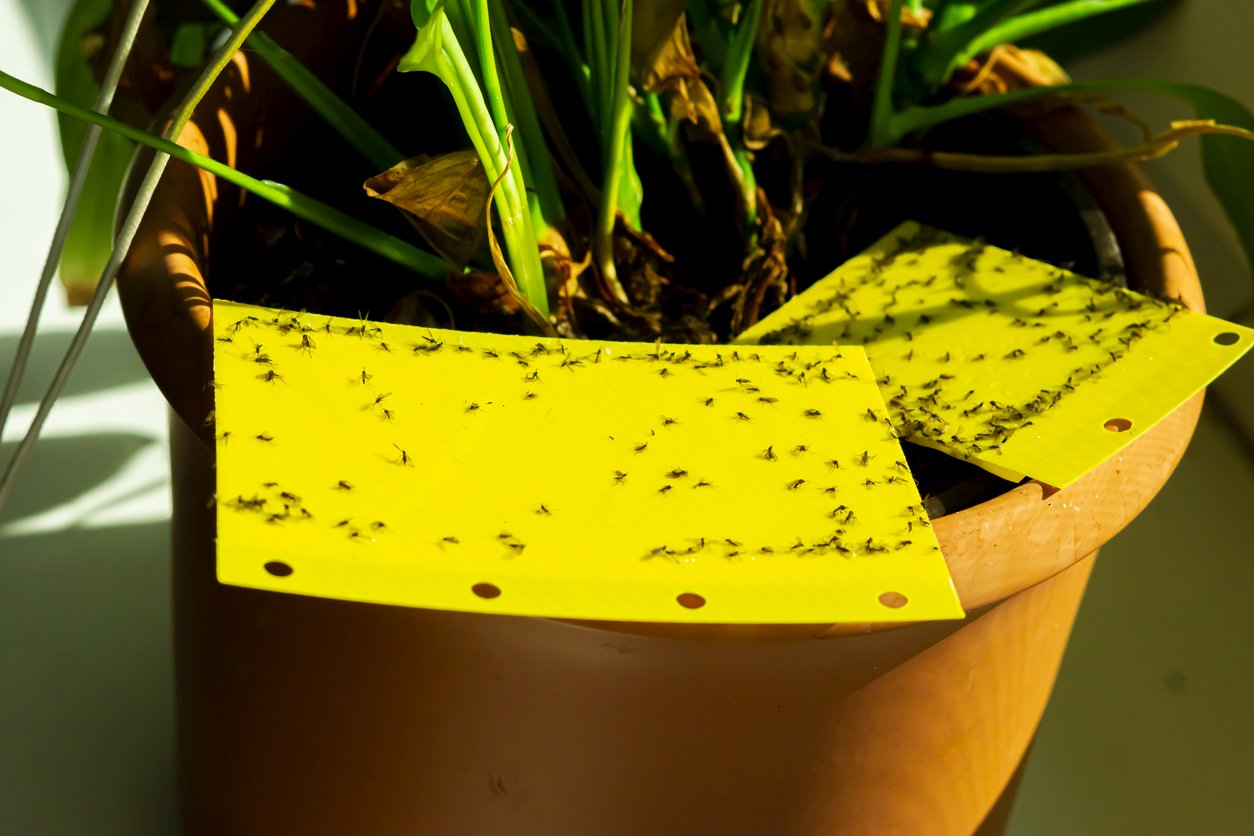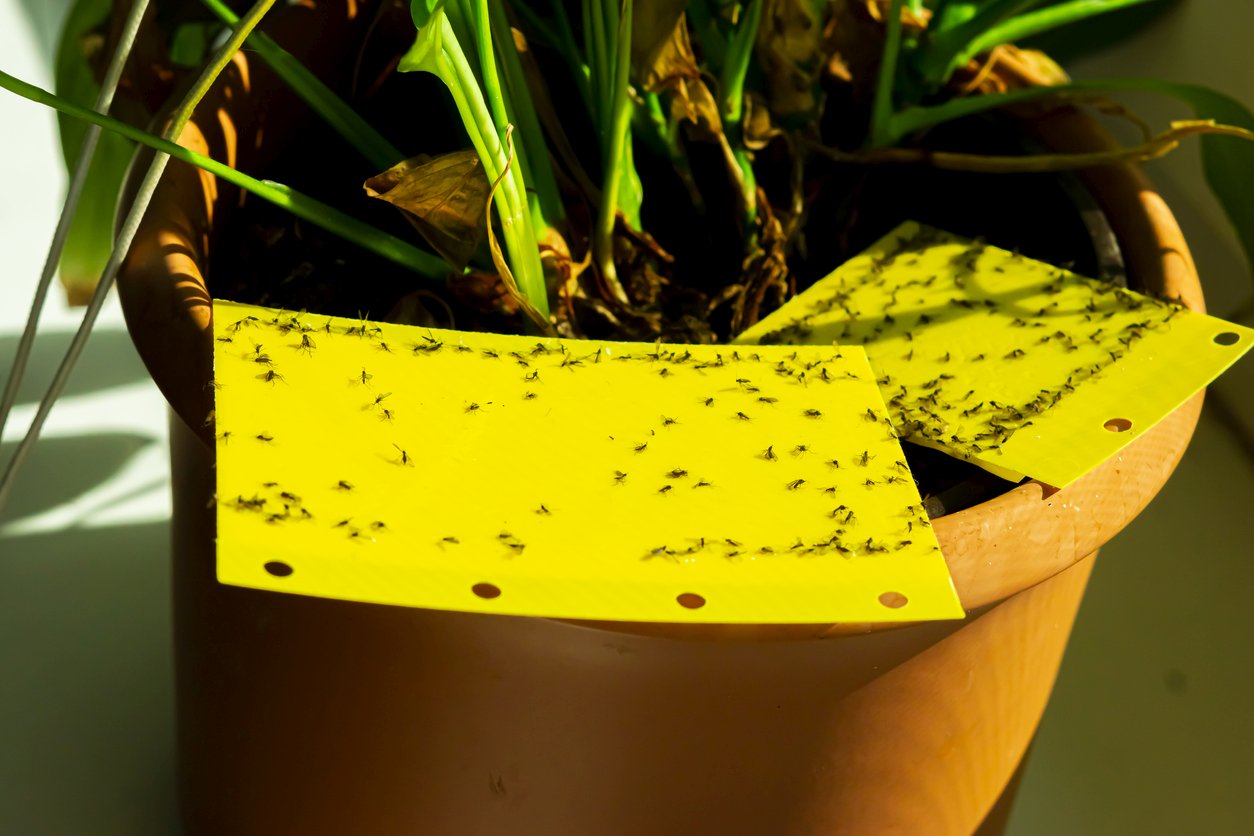How to Protect Your Plants from Gnat Infestations is a crucial aspect of maintaining a thriving indoor garden. Gnats, often attracted to moist soil and decaying organic matter, can quickly become a nuisance, damaging your plants and potentially introducing diseases.
Understanding the lifecycle and habits of these pesky insects is the first step in effectively controlling them.
From identifying the common types of gnats to recognizing the signs of an infestation, this guide provides practical solutions to prevent and eliminate these unwanted guests. We’ll explore preventive measures, effective control methods, and strategies for maintaining a healthy environment that discourages gnat growth.
Understanding Gnat Infestations

Gnats are small, flying insects that can be a nuisance to both humans and plants. While they may seem harmless, gnat infestations can cause significant damage to your plants, leading to stunted growth, wilting, and even death. Understanding the different types of gnats, the signs of an infestation, and the conditions that favor their growth is crucial for effective prevention and control.
Types of Gnats That Affect Plants
Gnats are a diverse group of insects, but some types are more common in plant infestations. Here are a few of the most prevalent:
- Fungus Gnats:These gnats are attracted to moist soil and decaying organic matter. They lay their eggs in the soil, and their larvae feed on fungi and roots, causing damage to plants. Fungus gnats are often seen hovering around the soil surface, especially in humid environments.
- Shore Flies:These gnats are also attracted to moist environments, and their larvae feed on decaying organic matter. They are often seen around water sources and can be a problem in greenhouses or areas with high humidity.
- Drain Flies:These gnats are known for their small size and distinctive wing patterns. They are attracted to damp, stagnant water, such as in drains, sinks, and clogged pipes. While they don’t directly feed on plants, their presence can indicate a potential problem with drainage and sanitation.
Signs and Symptoms of a Gnat Infestation
Several signs can indicate a gnat infestation in your plants:
- Adult Gnats:The most obvious sign is the presence of adult gnats flying around your plants. They are often small, black or gray, and may be seen hovering near the soil or around the plants.
- Larvae in the Soil:If you notice small, white, worm-like creatures in the soil, these are likely gnat larvae. They are often found near the surface of the soil and can be identified by their small size and segmented bodies.
- Yellowing or Wilting Plants:Gnat larvae can damage plant roots, leading to yellowing leaves, wilting, and stunted growth.
- Black Spots on Leaves:Some gnat species, such as fungus gnats, can leave black spots on leaves as they feed on the plant.
Ideal Conditions for Gnat Growth and Reproduction, How to Protect Your Plants from Gnat Infestations
Gnats thrive in specific conditions that provide them with the resources they need to reproduce and flourish:
- Moisture:Gnats prefer moist environments, making over-watered plants particularly susceptible to infestations.
- Organic Matter:Gnats are attracted to decaying organic matter, such as dead leaves, roots, and other plant debris.
- Warm Temperatures:Gnats reproduce more rapidly in warm temperatures, making greenhouses and indoor plants more vulnerable.
Effective Control Methods
Once you understand the root of the problem, it’s time to tackle the gnats head-on. There are various methods for controlling gnat infestations, ranging from natural remedies to commercially available insecticides.
Natural Remedies and Homemade Solutions
Natural remedies are often the preferred approach for gnat control, especially for those concerned about the potential risks of chemical insecticides. These solutions are generally safe for humans, pets, and plants.
- Apple Cider Vinegar Trap:This is a simple and effective method. Fill a shallow dish with apple cider vinegar and add a few drops of dish soap. The vinegar attracts the gnats, and the soap prevents them from escaping. Place the trap near the infested area.
- Yellow Sticky Traps:Gnats are attracted to yellow color. Yellow sticky traps, available at most garden centers, are designed to capture and trap gnats. They are particularly effective in areas with high gnat activity.
- Diatomaceous Earth:This natural powder, made from fossilized diatoms, is effective in killing gnats by dehydrating them. Sprinkle diatomaceous earth around the base of your plants and in areas where gnats congregate.
- Neem Oil:Neem oil is a natural insecticide derived from the neem tree. It is effective against a wide range of pests, including gnats. Mix a few tablespoons of neem oil with water and spray the solution on your plants, paying attention to the underside of leaves where gnats tend to hide.
- Peppermint Oil:The strong scent of peppermint oil is a natural repellent for gnats. Mix a few drops of peppermint oil with water and spray the solution around your plants and in areas where gnats are present.
Using Commercially Available Insecticides
Commercially available insecticides can provide faster and more aggressive control than natural remedies. However, it’s important to use these products cautiously and follow the instructions carefully.
- Identify the Insecticide:Choose an insecticide specifically designed for gnat control. Look for products containing active ingredients such as pyrethrins, permethrin, or bifenthrin.
- Read the Label:Carefully read the product label before applying the insecticide. Pay attention to safety precautions, application rates, and any restrictions on its use.
- Prepare the Solution:Mix the insecticide according to the label instructions. You may need to dilute it with water depending on the product.
- Apply the Insecticide:Spray the insecticide solution directly on your plants, paying attention to the undersides of leaves. Ensure the solution reaches areas where gnats are known to congregate.
- Repeat Application:Depending on the severity of the infestation, you may need to repeat the application every few days or weeks.
Comparing and Contrasting Gnat Traps
Gnat traps are designed to attract and capture gnats, reducing their population and preventing further infestations. There are several types of gnat traps available, each with its own advantages and disadvantages.
- Sticky Traps:These traps are effective at capturing gnats, but they can be messy and require frequent replacement.
- Light Traps:Light traps attract gnats to a bright light source and then trap them. They are effective at capturing large numbers of gnats but can also attract other insects.
- Vinegar Traps:These traps use the attraction of vinegar to lure gnats into a container where they drown. They are simple to make and effective but may not be as aesthetically pleasing as other traps.
Maintaining a Healthy Environment: How To Protect Your Plants From Gnat Infestations
Creating a healthy environment for your plants is crucial in preventing gnat infestations. Gnats thrive in moist, decaying matter, so keeping your plants and their surroundings clean and dry can significantly reduce their chances of multiplying.
Preventing gnat infestations is crucial for the health of your plants, especially if you’re going on vacation. While you’re away, your hanging plants might be more susceptible to these pesky insects. To ensure their well-being, consider using preventative measures like mosquito netting or diatomaceous earth.
For tips on keeping your hanging plants alive while you’re away, check out this helpful guide on How to Keep Hanging Plants Alive During Vacation. By taking these precautions, you can return to a home filled with thriving, gnat-free plants.
Proper Watering Techniques
Proper watering techniques are essential for preventing gnat infestations. Overwatering is a primary cause of gnat breeding.
- Allow the top inch of soil to dry out between waterings.
- Water deeply, ensuring the entire root ball is moistened.
- Avoid letting water sit in saucers or trays, as this creates a breeding ground for gnats.
- Consider using a moisture meter to gauge the soil’s dryness.
Plants Resistant to Gnat Infestations
Some plants are naturally resistant to gnat infestations due to their aromatic oils or other properties that deter these pests.
While gnats can be a nuisance, they are often drawn to overly moist soil. To combat this, consider incorporating hanging plants into your home decor, as they typically require less watering and can help to improve air circulation. How to Incorporate Hanging Plants in Your Home Decor offers tips on creating a stylish and practical setup.
This can not only enhance your home’s aesthetics but also contribute to a healthier environment for your plants, reducing the risk of gnat infestations.
- Rosemary: Its strong scent repels gnats.
- Lavender: The fragrant oil of lavender acts as a natural insecticide.
- Basil: Its pungent aroma is a deterrent for gnats.
- Catnip: This herb contains nepetalactone, a compound that repels gnats and other insects.
- Lemon Balm: Its citrusy scent is a natural gnat repellent.
Improving Air Circulation
Good air circulation around plants discourages gnat breeding by reducing humidity and creating a less favorable environment for them.
- Space plants appropriately: Ensure adequate spacing between plants to allow for proper air flow.
- Use fans: A small fan placed near plants can help circulate air and reduce humidity.
- Open windows: If possible, open windows to allow for natural air circulation.
Last Recap
By implementing the preventative measures, control techniques, and healthy environment practices Artikeld in this guide, you can effectively protect your plants from gnat infestations. Remember, early detection and proactive action are key to maintaining a thriving and pest-free indoor garden.
Enjoy the beauty and satisfaction of healthy, vibrant plants, free from the annoyance of pesky gnats.
FAQ Compilation
What are the most effective natural remedies for gnat control?
Natural remedies like diatomaceous earth, apple cider vinegar traps, and neem oil can be effective in controlling gnat infestations. Diatomaceous earth acts as a desiccant, dehydrating the gnats. Apple cider vinegar traps attract gnats and drown them. Neem oil, a natural insecticide, can be sprayed on plants to repel and kill gnats.
Can I use store-bought insecticides to eliminate gnats?
Yes, commercially available insecticides can be effective in controlling gnat infestations. However, it’s crucial to follow the instructions carefully and use them in a well-ventilated area. Always consider the potential impact on your plants and pets before using any chemical insecticide.
How often should I water my plants to prevent gnat infestations?
Watering frequency depends on the specific plant species and environmental conditions. However, avoid overwatering, as this creates a moist environment that encourages gnat breeding. Allow the top inch of soil to dry out between waterings.
